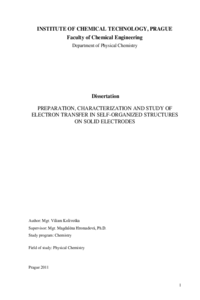Preparation, characterization and study of electron transfer in self-organized structures on solid electrodes
Příprava, charakterizace a studium přenosu elektronu v samoorganizovaných strukturách na pevných elektrodách
rigorous thesis (RECOGNIZED)

Reason for restricted acccess:
The annexes of the thesis or its part are inaccessible in accordance with article 18a (7) of The Code of Study and Examination in conjunction with Article 9 of the Rector’s Directive No. 6/2010.
View/
Permanent link
http://hdl.handle.net/20.500.11956/67423Identifiers
Study Information System: 152119
CU Caralogue: 990017859330106986
Collections
- Kvalifikační práce [20734]
Author
Faculty / Institute
Faculty of Science
Discipline
Physical Chemistry
Department
Department of Physical and Macromolecular Chemistry
Date of defense
25. 6. 2014
Publisher
Univerzita Karlova, Přírodovědecká fakultaLanguage
English
Grade
Recognized
Předkládaná dizertační práce se zaměřuje na elektrochemické, spektroelektrochemické, adsorpční, komplexační a vodivostní vlastnosti prodloužených viologenů různé délky (sloučeniny 1 až 6). Jejich molekuly by v budoucnosti mohli sloužit jako vodivé molekulární dráty v přístrojích molekulární elektroniky. Všechny studované sloučeniny vytvářejí na rozhraní rtuť/elektrolyt kompaktní monovrstvu paralelně ležících molekul s difúzně řízeným vznikem. Přítomnost adsorbovaných molekul na povrchu Au(111) byla potvrzena pomocí technik STM a PM IRRAS. Molekula prodlouženého viologenu obsahující jednu opakující se jednotku (sloučenina 1) reverzibilně přijímá čtyři elektrony, jako plně delokalizovaný systém. Molekula sloučeniny 2 však přijímá dva elektrony nezávisle a má proto dvě nekomunikující centra. Molekuly obsahující větší počet jednotek (n) přijímají v prvních dvěch redukčních krocích 2(n-1) elektronů (n-1 v každém). Chemická stabilita redukovaných forem sloučenin 1 až 6 byla potvrzena pomocí in-situ UV/VIS/NIR spektroelektrochemických technik. Vodivost elektrických spojů obsahujících molekuly prodloužených viologenů (měřena Taovou metodou) klesá exponencielně s délkou molekuly. V případě jiných typů prodloužených viologenů (sloučeniny 1' a 4') se zjistilo, že na jejich elektrochemické chování má výrazný...
The presented thesis focuses on electrochemical, spectroelectrochemical, adsorption, complexation and conductivity properties of extended viologens of variable length (the compounds 1 to 6). In the future, their molecules could serve as conducting molecular wires in the devices of molecular electronics. At the mercury/electrolyte interface, all studied compounds were found to form a compact monolayer with flat-lying molecules with the diffusion as the rate-determining step. The presence of adsorbed molecules on Au(111) surface was confirmed by STM and PM IRRAS techniques. The extended viologen molecule consisting of one repeating unit (the compound 1) was found to reversibly transfer four electrons, behaving as a fully delocalized system. On the other hand, the molecule of the compound 2 transfers two electrons independently, having thus two non-communicating centers. The molecules containing higher number of repeating units (n) transfer 2(n-1) electrons in the first two closely-positioned reduction steps (with n-1 electrons being independently consumed in each of them). Chemical stability of reduced forms of the compounds 1 to 6 was confirmed by UV/VIS/NIR in-situ spectroelectrochemical techniques. Electric conductance of junctions containing extended viologen molecules (scrutinized by Tao's...
